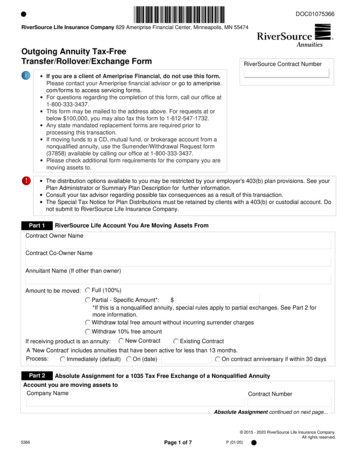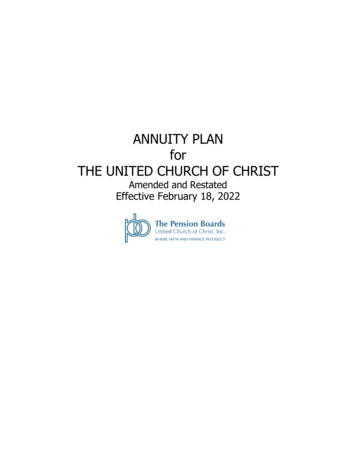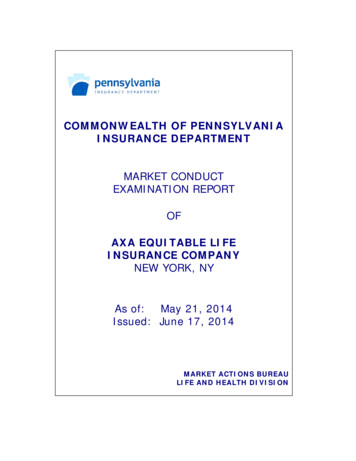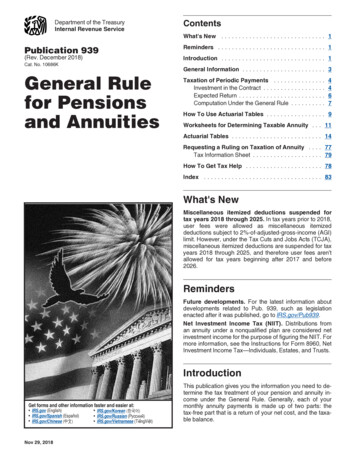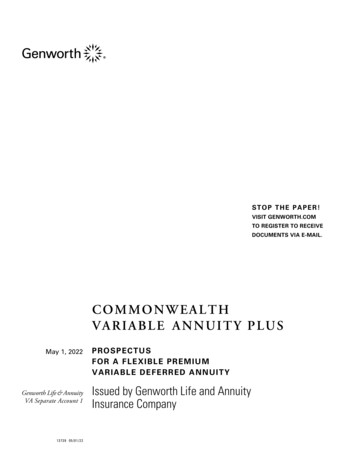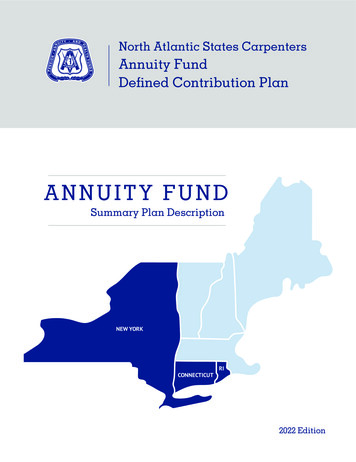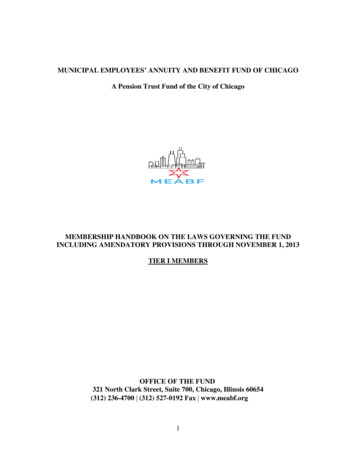
Transcription
MUNICIPAL EMPLOYEES’ ANNUITY AND BENEFIT FUND OF CHICAGOA Pension Trust Fund of the City of ChicagoMEMBERSHIP HANDBOOK ON THE LAWS GOVERNING THE FUNDINCLUDING AMENDATORY PROVISIONS THROUGH NOVEMBER 1, 2013TIER I MEMBERSOFFICE OF THE FUND321 North Clark Street, Suite 700, Chicago, Illinois 60654(312) 236-4700 (312) 527-0192 Fax www.meabf.org1
TABLE OF CONTENTSIntroduction .5General Provisions .6Inception of the FundEmployerParticipantReceiving Counseling and Applying for BenefitsAdministrationRevenue of the Fund and Rate of Participant and Employer ContributionsInvestment IncomeMEABF Fraud Reporting PolicyAnnuities for Participants .9Age and Service Requirements for Participant AnnuitiesMethods for Determining Participant AnnuitiesTable 1 – Percentage of Final Average Salary Payable under the Minimum Formula AnnuityAnnuity Increases After RetirementReversionary AnnuityTable 2 – Reversionary Annuity FactorsSurviving Spouse Annuities.17Age and Service Requirements for Surviving Spouse AnnuitiesMethods for Determining Surviving Spouse AnnuitiesDuty Death – Surviving Spouse AnnuitySurviving Spouses Not Entitled to AnnuityAnnuities for Children .22Credit for Service Prior to Date of Membership in the Fund .22Retirement Systems Reciprocal Act .23Disability Benefits .25Ordinary Disability BenefitsDuty Disability BenefitsRefund of Annuity Contributions .27Refund to a Participant upon Withdrawal from ServicePossible Refund to a Participant’s Children, Heirs, Estate, or Designated BeneficiaryRefund In Lieu of AnnuityRefund of Salary Deductions if Participant is Not MarriedRepayment of Refunds .282
TABLE OF CONTENTS (continued)Computation of Service Credit .28Qualified Illinois Domestic Relations Order (QILDRO).29Suspension of Benefits.29Present Income Tax Information .30Federal Income TaxAnnuitiesRefunds, IRA RolloversState of Illinois Income TaxDeductions from Annuity for Retiree Health Insurance .31Conclusion .313
TABLE INDEXTable 1: Percentage of Salary Payable Under Minimum Formula Annuity .13Table 2: Reversionary Annuity Factors .164
INTRODUCTIONTo the Employee Members (the “Participants”) and Retired Members (the “Annuitants”) in theMunicipal Employees’ Annuity and Benefit Fund of Chicago (the “Fund”):This Membership Handbook (the “Handbook”) has been prepared at the direction of theRetirement Board to provide general information about the benefits available to the Participantsof this Fund, and to the survivors of deceased Participants or Annuitants pursuant to the IllinoisCompiled Statutes Chapter 40 Act 5 (the “Pension Code”). The information contained in thisHandbook is for Fund members who first began participating in the Fund or an IllinoisReciprocal System (other than the General Assembly or Judges Systems) prior to January 1,2011.A detailed and complete coverage of all the applicable statutes in the Pension Code would defeatthe purpose of this Handbook. Correspondingly, it is not intended to contain a synopsis of all ofthe applicable provisions of the Pension Code, either. Individual circumstances will differ andmay require explanations and examples that would be different from those contained herein. TheIllinois Pension Code enacted by the Illinois General Assembly is the official authority andoriginal reference source of the Fund; and that code, as applied through the rules and proceduresadopted by the Fund, prevails in all questions of interpretation, operation, and administration ofthe Fund. The full text of the laws governing the Fund may be found in Articles 1, 8 and 20 ofthe Pension Code. In the event of a conflict between the provisions of this Handbook and thePension Code, the Pension Code will control.We encourage you to utilize this Handbook to educate yourself about the Fund and the benefitsthat are provided by law. This Handbook can also be found on our website at www.meabf.org.Please utilize our website to stay current on matters that may affect the Fund.Our sole mission is to administer the benefits provided in the Pension Code. Let us assure you ofour continued commitment to our mission; and, to our primary goals of providing you with thebest service, and preserving the fiscal integrity and financial stability of the Fund.We hope this Handbook will assist you in being more informed about the Fund and its purpose.Respectfully submitted,The Retirement BoardMunicipal Employees’ Annuity and Benefit Fund of Chicago5
GENERAL PROVISIONSInception of the FundThe Fund came into being in the year 1921 by virtue of an Act of the Illinois Legislature. Itsuperseded the former Municipal Pension Fund, which was created by an Act of the Legislaturein the year 1911, and also the Public School Employees’ Pension Fund, which was established inthe year 1903.EmployerAs defined in the Pension Code, the Employers include:1) The City of Chicago2) The Chicago Board of Education3) The Chicago Housing Authority (eligible employees)4) The Public Building Commission (eligible employees)5) The Retirement BoardParticipantParticipants of the Fund include:1) City of Chicago employees who do not contribute to another City of Chicago annuityfund (Firemen’s Fund, Policemen’s Fund, Laborers’ Fund);2) Elected Officials of the City of Chicago who, while in office, file written application formembership;3) Law Department and Board of Election employees with service of at least one-year whofile written application for membership;4) Chicago Board of Education employees who do not contribute to the Chicago Teachers’Pension Fund;5) Retirement Board employees;6) Employees of the Chicago Housing Authority or Public Buildings Commission who areeligible and who file written application for membership.The Fund does not consider the following as Participants:1) Employees who work in positions ordinarily not requiring at least four months of serviceduring a calendar year if salary is arranged on a monthly basis, or 700 hours of serviceduring a calendar year if salary is on a hourly basis, and certain minimum periods forpersons with salaries arranged on a weekly or daily basis.2) Employees working for the Employer while receiving an annuity from the ChicagoPolicemen’s, Firemen’s, or Laborers’ Pension Funds (other than a spouse annuity).Receiving Counseling and Applying for BenefitsParticipants may call the Fund office to set up an appointment to receive information about theirbenefit rights. Appointments are required to ensure that Fund staff is prepared to provide qualitycustomer service to visiting Participants. Participants may also request to have an estimate of6
their benefits sent to them by mail. Every effort is made to provide the information requested asquickly as possible.Participants may also visit the Fund’s website at www.meabf.org to find:1) Current News from the Fund2) Financial Reports3) Estimated Annuity Calculator4) Contact Information5) Downloadable Fund Forms6) Frequently Asked QuestionsPlease visit our website periodically to stay informed about the Fund.Participants considering retirement should request an estimate of benefits before finalizing theirresignation from service. If the Participant has any service credit to be established or reestablished, or has any service credit with another pension fund that has reciprocity with theFund (“Reciprocal Fund”), the Participant should request an estimate at least six months beforeresignation.Participants applying for retirement benefits can make an appointment with an applicationprocessor who will assist them through the application process. Participants may also downloadan Application for Retirement from the Fund website and submit it to the Fund.All members of the Fund must complete a Membership Record Form with the Fund. This formmust be complete and on file at the Fund to receive any benefit information from the Fund. TheMembership Record includes a Designated Beneficiary form that must be notarized in order tobe in effect.AdministrationA Board of Trustees, called “The Retirement Board”, administers the Fund. This board iscomposed of five members: the City Treasurer and the City Comptroller as ex-officio members,and three members who are elected by the Participants of the Fund.Revenue of the Fund and Rate of Participant and Employer ContributionsThe Fund derives revenue from three primary sources:1) Contributions from the Employer;2) Contributions from the Participants;3) Investment incomeEmployer ContributionsThe Retirement Board estimates annually the amount required from the Employer to pay for allannuities, benefits and administrative expenses. These amounts are to be paid into the Fundannually by the Employer. State statute limits Employer contributions to the amount of7
contributions by the Participants of the Fund made in the calendar year two years priormultiplied by 1.25.Participant ContributionsParticipants contribute 8.5% of salary as follows:1) 6.5% made from each salary payment for the purpose of providing an annuity for theParticipant.2) 1.5% from each salary payment for the purpose of providing a surviving spouse annuity.3) 0.5% from each salary payment for the purpose of providing an automatic increase inannuity after retirement.In addition to the above deductions, Board of Education Participants who have the Board ofEducation pick up 7% of the Participant’s pension contributions have an additional deduction of.595% made from each salary payment. This additional deduction allows the 7% Board ofEducation pickup to be added to the employee’s salary in calculating final average salary.The above stated percentages are applied to the amount of compensation or salary appropriated,fixed or arranged for the employee’s position, exclusive of overtime or extra salary.Investment IncomeGeneration of investment income on Fund reserves is a key source of revenue for the Fund. In asound pension plan, the investment income can finance a considerable portion of the annualannuity payments.MEABF Fraud Reporting PolicyBe advised that under Illinois law (P.A. 97-0651) MEABF is required to report to the State’sAttorney for investigation any reasonable suspicion of any falsified statement or record or anyfraudulent claim involving the Fund. Under State law, a person convicted of fraud may besubject to a fine of not more than 25,000 or imprisonment for not more than five (5) years orboth.8
ANNUITIES FOR PARTICIPANTSAge and Service Requirements for Participant AnnuitiesAn annuity is paid in equal monthly installments to eligible Participants with the first paymentgenerally due on the first day of the calendar month following the date of withdrawal forparticipants who have already reached the required age.The age and service requirements for annuity are as follows:Money Purchase Annuity 10 years of service, payable no earlier than age 55; Any years of service and withdrawal from service on or after the attainment ofage 60Minimum Formula Annuity 30 years of service, payable no earlier than age 50; 20 years of service, payable no earlier than age 55; 10 years of service, payable no earlier than age 60;Minimum Annuity - 850 per month 10 years of service and withdrawal from service on or after the attainment of age 60.If a Participant withdraws from service with the service credit required for a money purchaseannuity or a minimum formula annuity but has not reached the age required for the annuity tobecome payable, he or she may let the contributions remain in the Fund and receive an annuitybeginning upon application for such annuity after the attainment of the required age. (Please notethat the Participant must be at least age 60 at withdrawal from service to be eligible for theminimum 850 per month annuity.)In the event withdrawal from service occurs prior to attainment of the age required for benefits tobecome payable and the Participant wishes to receive an annuity, it is of the utmost importancethat he or she files an application for such benefit upon attainment of the required age foreligibility. Annuity rights will not begin until such application is filed.Participants with at least 10 years of creditable service who have attained age 55 at the time theywithdraw from service must accept an annuity if not eligible for a refund of their accumulatedcontributions. If the annuity is less than 800 a month, the Participant may elect to receive arefund of his or her accumulated contributions in lieu of the annuity.If the total credits for a Participant provide an annuity of less than 100 a month, a term annuityof 100 a month for a period of time is payable.9
Methods for Determining Participant AnnuitiesOutlined below are the three different methods which are used to determine the amount of aParticipant’s annuity. The Participant is entitled to the largest benefit.1) Money Purchase Method - Based on Accumulated Participant Contributions andEmployer ContributionsThis method uses the total amount accumulated from deductions from the Participant’s salaryand Employer contributions for the Participant’s annuity, together with interest to annuity startdate, to provide an annuity determined in accordance with insurance principles.The amount of annuity which a Participant may receive will, therefore, depend on age atretirement, years of service, and salary earnings throughout his or her period of service.The maximum annual annuity is an amount equal to 60% of the highest annual salary earned.If a Participant retires under age 60 with less than 20 years of service, the amount of Employercontributions are reduced by 10% for each year of service under 20 years in determiningaccumulated credits at retirement. The annuity payments begin no earlier than age 55.If retirement is due to expiration of ordinary disability credit, full Employer contributions areused to determine the annuity. The annuity payments can begin after the last disability paymentregardless of age.2) Minimum Formula Annuity MethodA Participant will be entitled to a minimum formula annuity if he or she withdraws from servicewith: at least 30 years of service credit (payable no earlier than age 50); orat least 20 years of service credit (payable no earlier than age 55); orat least 10 years of service credit (payable no earlier than age 60).In computing the length of service under a minimum formula annuity method of computation,the equivalent of one full month of service in a calendar year equals one-half year of servicecredit, and service in five additional months constitutes one full year of credit.EXAMPLE:If you began working on December 1, 1990 and worked continuously until June 30, 2013, youwould be credited with 23.5 years of service credit. You would receive a one-half year credit for1990, 22 years for the period from January 1, 1991 through December 31, 2012 and 1 year for2013.10
Computing a Minimum Formula AnnuityStep 1: Determine the final average monthly salaryFinal average monthly salary is the highest average monthly salary for any four consecutiveyears within the last ten years of service immediately preceding the date of retirement. Usuallythis is the average of the last 4 years of service.Final average monthly salary does not include overtime or extra salary. The salary for Board ofEducation employees who have the Board of Education pick up 7% of the Participant’s pensioncontributions is the straight time rate plus 7%.The normal salary base is for a 12 month per year, 5-day workweek of 8 hours a day and 40hours a week with straight time rate of compensation. The normal salary base may be adjustedaccording to a position’s normal and established work period.The annual wage for any year is the greater of: such monthly, weekly, daily or hourly rate that was applicable for the greater number ofmonths, weeks, days or hours in the year under consideration, orthe average of such monthly, weekly, daily, or hourly salary or wage rate as wasapplicable for the total number of months, weeks, days, or hours, respectively in eachyear under consideration.STEP ONE EXAMPLE:Final YearOne Year EarlierTwo Years EarlierThree Years EarlierTotalDivided by 48 monthsFinal Average Monthly SalaryAnnualSalary 46,000 44,000 41,000 37,000 168,00048 3,500Step 2: Determine the percentage of final average monthly salary based on years of servicecredit.The total number of years of service is multiplied by 2.4%. The maximum percentage is 80% ofthe final average monthly salary.STEP TWO EXAMPLE: 23.5 Years of Service x 2.4% 56.4%11
Step 3: Determine the age discount if retirement is earlier than age 60 and Participant has lessthan 25 years of service.There is no reduction in the percentage of final average monthly salary for retirement on or afterage 60. For retirement before age 60 with less than 25 years of service there is a discount of.25% for every month or fraction thereof that the Participant is under age 60.STEP THREE EXAMPLE:Age at RetirementDiscount(0.25% per month)0%3%6%9%12%15%605958575655Step 4: Multiply the percentage of final average monthly salary from Step 2 by the differencebetween 100% and the age discount determined in Step 3 to arrive at the percent of final averagemonthly salary if an age discount is applicable.STEP FOUR EXAMPLE:Age at% of Final AverageRetirement Monthly Salary(calculated in Step 2)6056.4% x5956.4% x5856.4% x5756.4% x5656.4% x5556.4% xDiscount Factor(calculated in Step 3)100% 100% - 3% 100% - 6% 100% - 9% 100% - 12% 100% - 15% % of Final AverageSalary (to be used inStep 5)56.40%54.71%53.02%51.32%49.63%47.94%Step 5: Multiply the final average monthly salary by the percentage determined in Step 4 todetermine the monthly annuity.STEP FIVE EXAMPLE:Using the same final average monthly salary of 3,500, the amount of annuity would be:12
Age atRetirement605958575655Final Average% of Final AverageMonthly Salary Monthly Salary(from Step 4) 3,500 x56.40% 3,500 x54.71% 3,500 x53.02% 3,500 x51.32% 3,500 x49.63% 3,500 x47.94% AnnuityAmount 1,974.00 1,914.85 1,855.70 1,796.20 1,737.05 1,677.90The factors combining the age discount with the percentage based on length of service can befound in TABLE 1 that follows. The total percentage cannot exceed 80%.TABLE 1Percentage of Final Average Monthly Salary Payable under the Minimum Formula *80.00*80.00*80.00*80% is the Maximum13
3) Minimum Annuity MethodA Participant withdrawing from service at age 60 or over, with at least 10 years of service in theFund will receive a minimum annuity of 850 per month.Annuity Increases after RetirementAny Participant receiving a lifetime annuity who retires on or after the attainment of age 60 isentitled to automatic annual increases equal to 3% of the currently payable gross monthlyannuity. These Annuitants are entitled to an increase on January 1st of each year beginning withthe January following their first annuity payment date.Participants, who retire between the ages of 50 and 60, generally begin receiving such increasesthe earlier of : January 1st of the 3rd year anniversary of their first annuity payment date, provided theyare at least age 53, or The later of January 1st of the year of the first annuity payment following the Annuitant’sattainment of age 60 and January 1st following the first annuity 12/15/20176/30/20176/30/20176/30/2017First 77/1/2017Date AnnuitantTurns 15/2022Date of 0191/1/2020In combination with Employer contributions, Participants contribute 0.5% of salary to helpdefray the cost of the annual increase.These automatic annual increases do not apply to annuitants who are receiving a term annuity,survivor annuitants or reversionary annuitants.Employees not entitled to these increases or who resign and take a refund, receive a refund of the0.5% deducted. No interest is paid on the 0.5% deduction when refunded.14
Reversionary AnnuityA reversionary annuity is a reduction of a Participant’s annuity to provide a lifetime annuity for aspouse, parent, child, brother or sister, such annuity to begin upon the death of the Annuitant.A Participant must make the election to reduce his or her annuity at or prior to retirement. Theelection is made by filing a written designation with the Retirement Board indicating the amountby which the Participant elects to reduce their annuity and the person to whom the reversionaryannuity would be payable, in the event such designated person should outlive the Participant.The amount of reduction may be decided at a later date than the intent to reduce as long as theamount is decided at or before retirement.The written designation can only be revoked or canceled as follows:1) by a written request by the Participant at any time prior to retirement on annuity;2) upon the death of the Participant prior to retirement on annuity;3) upon the death of the designated person prior to the Participant’s retirement on annuity;or4) upon the death of the Annuitant before the expiration of one year (365 days) from thedate the written designation was filed with the Retirement Board for a reversionaryannuity for a parent, child, brother, or sister, even though the Annuitant has retired andreceived the reduced annuity for any part of such one-year period.If the designated person dies prior to the Annuitant, the Annuitant’s full annuity before reductionwill be restored beginning on the date of the designated person’s death. There would be noretroactive payment of the difference between the full and reduced annuity.The reversionary annuity to the designated person will begin effective the first of the monthfollowing the date of death of the Annuitant and will continue to be paid monthly thereafter untilthe death of the designated person.The amount by which a Participant may reduce the retirement annuity is subject to the followinglimitations:1) Participants may reduce the retirement annuity by an amount up to a maximum of 400 amonth;2) The amount of monthly reversionary annuity payable to the designated person may not beless than 50 a month; and3) The amount of monthly reversionary annuity payable to a designated spouse plus theamount of surviving spouse annuity may not exceed the reduced annuity payable to theAnnuitant.The Annuitant’s 3% automatic annual increase after retirement is based on the currently payableunreduced retirement annuity of the Annuitant. The reversionary annuitant does not receiveautomatic annual increases.15
The amount of the monthly reversionary annuity is determined by multiplying the amount of themonthly reduction in the Annuitant’s annuity by a factor shown in TABLE 2 that follows.The factor is based on: (a) the age of the Participant on the date of retirement; and (b) thedifference between the age of the Participant and the age of the reversionary annuitant as of theretirement date of the Participant.TABLE 2Reversionary Annuity FactorsFor Every 1 Reduction in a Participant’s Retirement Annuity, a Reversionary Annuitant for theAges Stated Would Be Entitled to the Multiple Below:ReversionaryAnnuitant’sAgeYears Younger30 or more25-2920-2415-1910-145-90-4Years Older1-56-1011-1516-2021-2526-3031 or moreParticipant’s Age58-60 61-63 64-6650-5152-5455-5767-6970 .325.878.3512.8223.28EXAMPLE:A Participant, age 65 on the date of retirement, has designated a reversionary annuitant who wasfour years younger on the same date. For every 1 reduction in retirement annuity, thereversionary annuity would be 2.61, subject to the limitations discussed herein. (In determiningages, months are disregarded.) A 100 per month reduction by the Participant would give thereversionary annuitant an amount of 261 per month payable for the lifetime of the reversionaryannuitant. A Participant interested in providing for a reversionary annuity should contact the Fund. TheFund can provide information on the different possibilities available. An interested Participantcan download the necessary reversionary form from our website at www.meabf.org.16
SURVIVING SPOUSE ANNUITIESReferences to spouse in this Handbook also apply to civil union partners. The same eligibilityrequirements would need to be met by the civil union partner as that required for a survivingspouse.Age and Service Requirements for Surviving Spouse AnnuitiesThe following surviving spouses are entitled to a surviving spouse annuity:1) the surviving spouse of a Participant whose death occurs while in service;2) the surviving spouse of an Annuitant whose death occurs after retirement on annuity, ifmarriage occurred while the Participant was still in service;3) the surviving spouse of a Participant whose death occurs after withdrawal from service,having at least ten years of service credit, if marriage occurred while the Participant wasstill in service, provided that the Participant did not take a refund of his or hercontributions to the Fund.A surviving spouse annuity is paid in equal monthly payments. The payments begin after thedeath of the Member. The surviving spouse annuity begins effective on the first of the monthfollowing the date of the Member’s death. The last monthly payment occurs on the first day ofthe month of the surviving spouse’s death or termination of a term annuity.If the total credits for surviving spouse annuity provide an annuity for life of less than 100 amonth, a term annuity of 100 a month for a period of time is payable.The maximum amount of annuity the surviving spouse can receive for a non-duty related death is50% of the highest salary received by the Participant, regardless of the method of computation.Methods for Determining Surviving Spouse AnnuitiesThere are three basic methods used to determine the amount of a surviving spouse annuity for anon-duty death. The surviving spouse is entitled to the largest benefit, subject to the 50% ofhighest salary maximum.1) Money Purchase Annuity – Based on Accumulated Salary Deductions and CityContributionsThis method of computing the surviving spouse annuity is known as the money purchasemethod. That is, the accumulated salary deductions and Employer contributions with interest tothe credit of the spouse are used to provide the spouse’s annuity. Currently, Participantscontribute 1.5% of salary for the purpose of providing a surviving spouse annuity. The Employerthen contributes an amount equal to 2% of salary. To these amounts interest is added. Suchsalary deductions and Employer contributions continue until the Participant retires from service.17
The amount of surviving spouse annuity, just as in the case of the Participant’s own annuity, isdetermined by the period of service and salary of the Parti
1) City of Chicago employees who do not contribute to another City of Chicago annuity fund (Firemen's Fund, Policemen's Fund, Laborers' Fund); 2) Elected Officials of the City of Chicago who, while in office, file written application for membership; 3) Law Department and Board of Election employees with service of at least one-year who
